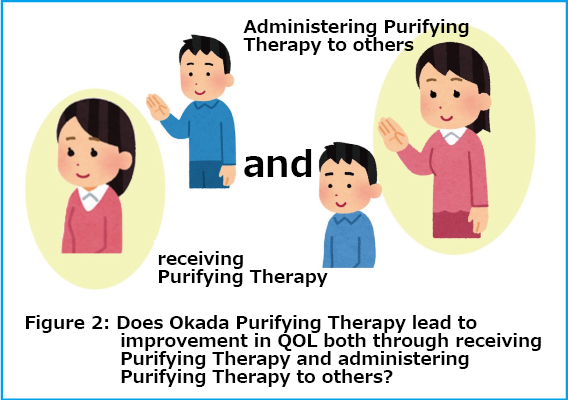Kiyoshi Suzuki, MD, PhD
President, MOA Health Science Foundation
In the previous report, the hypertension patients attending the Tokyo Wellness Center had good blood pressure control, and 30% of the patients were able to reduce or discontinue the drug. Each of the Okada Health and Wellness Program—including Okada Purifying Therapy, Healthy Food Program, and Arts and Culture Program—may have promoted the improvement in hypertension. Then, if you practice the Okada Health and Wellness Program, will you become healthy and happy, but will your quality of life (QOL) improve?
1.Difficulty in objectively evaluating QOL
Whether or not you feel healthy and happy affects your QOL, but it is based on highly subjective judgments and is difficult to evaluate objectively. Knowing its limitations, questionnaires for measuring QOL have been developed and are widely used.
However, there were various limitations in using it in our research, so we created a QOL questionnaire (MQL-10) that is easier to use. Before actually using it, Tomoaki Kimura, senior researcher, executive director of the MOA Health Science Center, took the lead in examining consistency with the QOL questionnaire widely used internationally to increase objectivity. (Altern Med Studies. 2012;2:e12, MOA Health Science Center Research Report 2009;13:73-84).
2.QOL survey methods and results
 In conjunction with the nationwide survey on the efficacy and safety of Purifying Therapy introduced in Columns 7 and 8, we asked more than 5,000 people to fill out the MQL-10 questionnaire and the degree of practice of the Okada Health and Wellness Program over a period of more than three months. I thank over 5,000 people for their cooperation. With so much data collected, a fairly objective trend emerges.
In conjunction with the nationwide survey on the efficacy and safety of Purifying Therapy introduced in Columns 7 and 8, we asked more than 5,000 people to fill out the MQL-10 questionnaire and the degree of practice of the Okada Health and Wellness Program over a period of more than three months. I thank over 5,000 people for their cooperation. With so much data collected, a fairly objective trend emerges.
Here are some particularly interesting results. It was easier to improve QOL by practicing two or even three of the three elements of the Okada Health and Wellness Program together rather than practicing just one of them.
In addition, when examining the degree of practice of each element, QOL improved as the Healthy Food Program and Arts and Culture Program were practiced, but there was not much relationship between the frequency of Purifying Therapy and QOL. This trend was also seen among non-MOA members. This result was surprising.
3.The effect of the Okada Health and Wellness Program that can be said from the results of the QOL survey
From my own experience, I believe that QOL improves when two elements of the Okada Health and Wellness Program are practiced rather than one, and when three elements are practiced rather than two. However, are you convinced that frequent Purifying Therapy did not significantly improve the quality of life? How should we think about this?
First, QOL questionnaires, including the MQL-10 questionnaire, may not correctly assess QOL. Second, the amount of previous experience with Purifying Therapy may affect the results. A study of people who had little exposure to Purifying Therapy might have yielded different results.
Furthermore, there would have been some people who reduced the number of Purifying Therapy because their QOL improved, and others who increased their number of Purifying Therapy because their QOL did not improve. If there are many such people, the higher the number of Purifying Therapy received, the lower the QOL. In addition, the Healthy Food Program and the Arts and Culture Program require a positive attitude to practice on your own; but if you just receive Purifying Therapy, you can be passive, and this difference in attitude may have influenced the improvement of QOL.
 In the research introduced this time, it is difficult to improve QOL by simply receiving Purifying Therapy, and the results show the importance of practicing the three elements of the Okada Health and Wellness Program in a well-balanced manner. If you are a MOA member, it may be important for you to have a positive attitude to administration of Purifying Therapy on others.
In the research introduced this time, it is difficult to improve QOL by simply receiving Purifying Therapy, and the results show the importance of practicing the three elements of the Okada Health and Wellness Program in a well-balanced manner. If you are a MOA member, it may be important for you to have a positive attitude to administration of Purifying Therapy on others.
If you want to know more about the details, please read the original article published in the international journal of integrative medicine (J Alternate Complement Med 2019;25:336–345). The MOA Health Science Center Research Report (2019; 23:57-70) has been reprinted in Japanese, so please read it.
So, how far can the effects of Okada Purifying Therapy be proven scientifically? Next time, I will talk about the scientific facts of Purifying Therapy.
【Profile】
Kiyoshi Suzuki
Graduated from Chiba University School of Medicine in 1981. medical doctor. After working as Deputy Director of Pediatrics at Sakakibara Memorial Hospital, Seijo Clinic, (Medicine) Gyokusenkai MOA Takanawa Clinic and Tokyo Medical Clinic Director, president of MOA Health Science Center and Honorary Director of Tokyo Medical Wellness Center. Director of The Society for Integrative Medicine Japan and Chairman of the International Committee. In 1994, he received the Young Investigator’s Award from the Japanese Society of Pediatric Cardiology.






